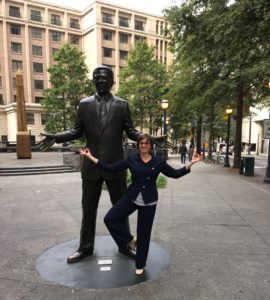 As a long-time student of yoga, I have come to appreciate the quiet helper that is there for us in a variety of situations if we care to notice – our own breath. We often take it for granted, but if we learn to pay attention to it and work with it consciously, it can help us regulate stress, boost confidence and increase impact of our speech.
As a long-time student of yoga, I have come to appreciate the quiet helper that is there for us in a variety of situations if we care to notice – our own breath. We often take it for granted, but if we learn to pay attention to it and work with it consciously, it can help us regulate stress, boost confidence and increase impact of our speech.
When you are about to pronounce the first word of your speech, do you do it on an inhale or exhale? Have you noticed or just guessed your answer? Now, go ahead and pretend you are about to speak. First, exhale and then start speaking. Then, inhale and start speaking. Do you notice the difference? When you take a full breath and fill your chest with air before speaking, the sound traveling on the waves of air as you exhale is more resonant and reaches farther. There are many other reasons why public speakers may want to tap into the power of breath.
- You brain needs oxygen. Around 20% of all oxygen that enters the body goes to the brain. Many people are shallow breathers, especially if they are sitting at their desks in a slouched position. Taking deep breaths before and during your speech may improve the focus and clarity of thinking. Studies suggest that we yawn when we need to bring more air and blood flow to the brain to cool it and make it more focused. Now that you know why we yawn, don’t take it personally when your audience members start yawning – their brains may just need more oxygen.
- Deep breathing helps to release stress. Dissolve your pre-speech jitters with a breathing pattern. There are various patterns that can help you regulate your physical and mental states by counting the duration of inhales and exhales. For example, you can inhale for a count of four, then exhale for a count of four. Notice how you fill up your belly, then your chest as you take a deep breath. The goal is to stop racing thoughts and calm the nerves.
- Breathing regulates your speaking tempo. You may have experienced it or heard someone else speak really fast and appear out of breath. It is not a comfortable state to be in or to listen to because it leaves us agitated. Natural breathing helps you slow down and take pauses that are needed for your words to sink in. Think of silence as the white space in a speech. The white space in a painting provides contrast so that other elements become prominent. Similarly, pauses are needed to increase the impact of your words.
- Breathing can replace your filler words. Nobody plans those “ums” and “uhs” in their speech, but they pop up nonetheless when we lose our train of thought or get briefly distracted by something else. To regroup, try taking a breath or two instead of filling the space, and then move on to the next point.
- Breathing varies your pitch. You don’t want to sound monotonous. Breathing can help you raise or lower you pitch depending on your message, character or a line in a dialogue. Here is a fun experiment…Take a deep breath and try speaking in a really low voice. Impossible, right? Now, exhale fully and try to speak in a high-pitched voice. That’s hard too. Now, you know how to use your inhales and exhales to vary the pitch naturally and effectively.
How do you use breathing techniques in your public speaking?
Click HERE to take a free assessment and find out your Speaker Persona.

Leave A Comment
You must be logged in to post a comment.